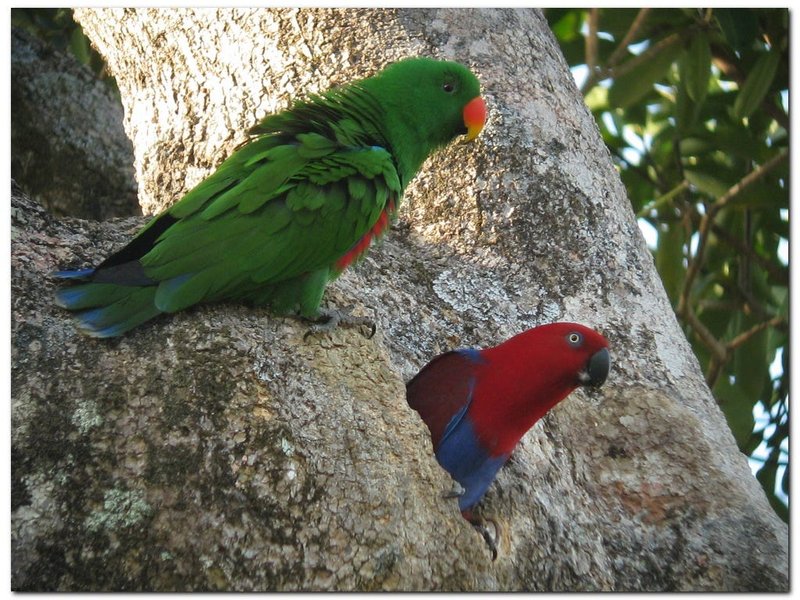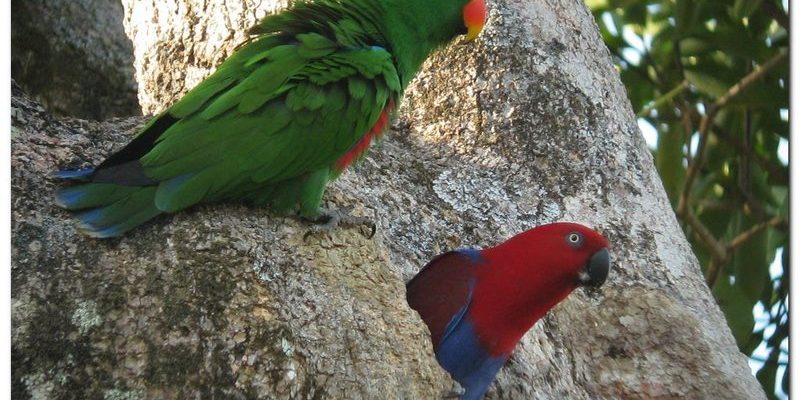
You might be surprised to learn that the story of the Eclectus Parrot is rich and full of twists and turns. Originating from the tropical forests of Melanesia, these birds have adapively thrived in a specific environment that shapes who they are today. As we dive deeper into their history, we’ll uncover how their unique characteristics developed over time and what makes them special in the parrot world.
Origins of the Eclectus Parrot
The Eclectus Parrot (Eclectus roratus) traces its roots back to the lush, green forests of islands like New Guinea, the Solomon Islands, and parts of Australia. The unique habitat these birds call home has played a significant role in their development. Living in dense rainforests, they’ve adapted to a diet rich in fruits, nuts, and flowers, which has influenced their bright colors and impressive vocal talents.
Interestingly, the Eclectus Parrot showcases sexual dimorphism, meaning males and females look drastically different. The bright green color of the males isn’t just for show; it provides excellent camouflage among the foliage. On the other hand, the females are decked out in a bold red and purple mix, which might seem counterintuitive for hiding. This striking contrast likely evolved from their roles in nesting and attracting mates, where standing out can be a good thing.
As we look back at their origins, we see that these parrots were first described scientifically in the 18th century. British explorer and naturalist George Shaw was among the first to document the species in 1805, although they were often confused with other parrots due to their unique appearance.
Behavior and Social Structure
Eclectus Parrots are known for their friendly and social nature, which makes them a popular choice for pet owners. In the wild, they typically live in loose flocks, where they communicate and forage together. Their social structure is fascinating; they are cooperative by nature and spend most of their time interacting with one another, which is essential for their well-being.
You might be wondering how their social behavior translates into pet ownership. Well, these parrots thrive on interaction and mental stimulation. Without sufficient socializing, they can become bored or depressed. That’s why many owners often find themselves chatting or even singing with their Eclectus Parrots. It’s like having a feathery friend who loves to join in on the fun!
Their playful personalities and ability to mimic sounds make them entertaining companions. Honestly, it’s hard not to fall in love with their quirky antics and charming vocalizations. Just remember, though, they require plenty of attention and interaction to stay happy and healthy.
Diet and Feeding Habits
In the wild, Eclectus Parrots primarily feast on fruits, nuts, seeds, and flowers. They have developed a specialized digestive system that allows them to efficiently process these foods. This natural diet is crucial for maintaining their striking colors and vibrant energy levels.
When it comes to feeding your pet Eclectus, it’s essential to mirror their natural diet as closely as possible. A good mix of fresh fruits and vegetables should be the cornerstone of their meals. Foods like apples, grapes, and carrots are not only nutritious but also help keep playtime exciting.
Here’s the thing: many owners might be tempted to feed their parrots just seeds or pellets. However, these can lack the essential nutrients that promote good health. Make sure to provide a wide variety of foods to ensure your feathered friend gets everything they need. Think of it like this: a balanced diet is not just good for humans; it’s the same for our avian pals!
Breeding and Nesting Behavior
The breeding habits of Eclectus Parrots are as interesting as their vibrant plumage. In the wild, these parrots typically nest in tree cavities, which provide protection for their eggs and chicks. Females take on the primary role of incubation and care, while males help by providing food and protection.
Interestingly, the female Eclectus often lays a clutch of approximately two to four eggs, which she incubates for around 28 days. Once the eggs hatch, the males continue to be involved, bringing food to the female and her young, ensuring that everyone has enough to eat during this demanding period.
If you’re considering breeding Eclectus Parrots, remember that it’s a commitment. Breeding successfully requires specific conditions and a solid understanding of their needs. Many enthusiasts find it rewarding but also challenging, as it involves not just understanding their behavior but also providing the right environment for them to thrive.
Domestication and Pet Ownership
Over the years, the Eclectus Parrot has become one of the most sought-after pet birds worldwide. Their striking appearance, engaging personalities, and remarkable vocal skills make them a favorite among avian enthusiasts. As more people became aware of their unique traits, demand for these beautiful birds skyrocketed.
However, domestication brings its own set of responsibilities and challenges. Eclectus Parrots thrive in environments where they can interact with their owners, so commitment is key. You might be thinking about how to accommodate one of these charming birds in your home. Make sure to create a stimulating environment that includes toys, perches, and opportunities for social interaction.
Here’s the thing: owning an Eclectus is not just about having a pet; it’s about building a relationship. These birds require consistent attention and mental engagement, which means spending time with them daily. The reward? A loyal companion who brings joy and laughter into your life.
Conservation Status and Challenges
Despite being popular as pets, Eclectus Parrots face challenges in the wild. Their natural habitats are threatened by deforestation, habitat loss, and hunting. These factors have led to a decline in their populations in some regions, making conservation efforts crucial.
Organizations focused on wildlife conservation are working hard to protect these parrots and their habitats. Preserving the rainforests of Melanesia is essential not just for the Eclectus but for countless other species that share this ecosystem. You might wonder how you can help. Supporting conservation organizations or even choosing to adopt an Eclectus from a responsible breeder can make a difference.
Remember, the future of the Eclectus Parrot relies on a balance between pet ownership and protecting their wild counterparts. Responsible breeding and conservation efforts are key in ensuring these vibrant birds continue to thrive for generations to come.
The history and evolution of the Eclectus Parrot is a captivating tale of adaptation, social structure, and vibrant colors. From their fascinating origins in the rainforests of Melanesia to their popularity as pets, these birds represent a unique blend of beauty and complexity. Understanding their needs, behaviors, and the challenges they face in the wild helps us appreciate them even more.
As we wrap up this journey through the life of the Eclectus Parrot, it’s essential to remember that owning a pet is a long-term commitment. This charming bird can fill your home with laughter and joy when given the right care and attention. Let’s celebrate these incredible creatures and do our part to ensure their continued survival both in the wild and in our hearts!

